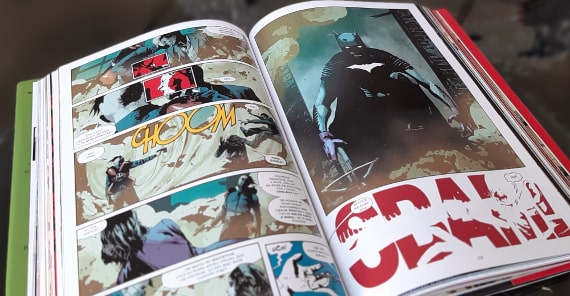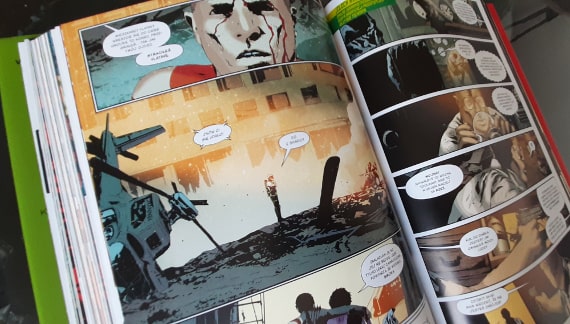Like in a classic action movie, Olivier Queen gets away from any oppression. The world thinks twice that the hero has died when he unexpectedly returns. What gives the common man such survival strength? You will find out as you learn about the new genesis of Green Arrow.
Green Arrow from the DC Deluxe series is a solid, thick volume – it’s hard to hold in one hand! It consists of materials from 20 different notebooks by eminent authors: screenwriter Jeff Lemire and cartoonist Andrea Sorrentino. The individual stories are separated by original covers that look like beautiful posters. Additional materials also include alternative cover designs and initial sketches of villains, as well as an introduction by one of the most popular comic book writers, Mark Millar, and an afterword by Kamil M. Śmiałkowski, from whom we can learn more about the timing of comics about the Green Arrow . For example, we can read an interesting fact that the first Green Arrow appeared in 1941 in the More Fun Comics comic.at the very beginning of DC Comics history – only 2 years after Batman was “born” and 3 years after creating Superman.
The volume is crowned with an elegant, hard, black cover covered with a glossy overlay with monochrome graphics in a simple, poster-like design, emphasizing the green and red colors that dominate the entire comic book.

Monochrome, monothematic
Artistic, poster-like style, monochrome colors, high contrast and the lack of tonal transitions are the hallmarks of Green Arrow notebooks. I must admit that the effect is very coherent and it nicely binds them together into one coherent volume. Although of course I am aware that not everyone will be satisfied with such simple aesthetics. For example, when looking at graphics showing only black and white outlines of figures on a red or green background, one can get the impression that these are unfinished sketches that the creators have forgotten to color. When you were looking for the “culprits” of this idea, Marcelo Maiolo, Andrea Sorrentino, Matt Holingsworth and Hi-Fi are responsible for the colors.
Personally, this manner does not bother me. I think it is very thoughtful and makes a pleasantly harmonious impression, and the framed “uncolored” elements bluntly emphasize important details.
Small frames also speed up the action, sometimes they are even twisted and detached from the regular board, giving an interesting diffusion effect of the picture falling apart or the world spinning, e.g. when Count Vertigo uses his powers. They also show the heroes’ weak points, and in one place this motif even served as an X-ray to show how the arrow pierces the heart.
In some places, such help seems even necessary, because due to the monochromatic nature of the graphics, many details are lost in the shadows. So much so that when Batman appears as a guest in the drawing that covers almost the entire page, we can only see his dark outline with white glowing eyes and a strip of round teeth. In such an approach , it is distinguished from the Moomin Buki only by pointed ears and a bat mark on its chest.
Sometimes a single color extends over several pages, which separates the presented threads. The most common are dark colors: gloomy green, gray-blue or yellow-orange – used to distinguish flashbacks.
Both the bleak colors and the return to painful stories from the past expose the darkness that is so typical of DC Comics.

Dark past and social problems
It is the dramatic events that most often create the genesis of superheroes and villains in DC comics, where ordinary people, under the influence of difficult experiences, strong emotions and an irresistible desire for revenge, become someone special, superhumanly strong and unstoppable.
Green Arrow by Lemire and Sorrentino re-tells the fate of young and handsome millionaire Oliver Queen, adding to them several contemporary social problems. As in the previous Green Arrow comics, there is an island theme where Queen crashes like Robinson Crusoe and fights for survival, acquiring amazing archery and hunting skills. They allow him to later track down and annihilate Seattle criminals, as well as protect the weaker, making him look like a hooded Robin Hood.
Olivier also struggles with personal problems. His mother fell ill with cancer and had to look after her on his own before she died. After that, he withdrew from life and developed alcoholism. This shows that Green Arrow, in addition to being a superhero, is also an ordinary human, which adds depth and authenticity to this character. He becomes even more mediocre when he loses all his family fortune, when a villain called Komodo blows up Queen Industries’ headquarters.
Social problems are also illustrated by the example of the villain – Count Werner Vertigo – descending from the royal family of Vlatava. Raised by his mother, a drug addict and a prostitute, he is handed over to a facility where he will be subjected to experiments to turn him into a destructive weapon. It is the later hatred of his mother that exerts the strongest influence on him and gives him an irresistible desire for revenge.

The main theme – shields and arrows
Werner is implanted with a special electronic implant (it looks like a small green shield in the center of his forehead), thanks to which he gains the power to generate an electro-magnetic wave.
The circular force that gives everyone a headache has been pictured as a huge shield covering the entire pages of the comic. This motif appears very often in Vertigo notebooks.
In addition, the Count on his exposed chest has a visible (probably tattooed) huge red spiral that looks like a target inviting a shot. By the way, it’s a pretty bad idea for a tattoo, considering that the archer is his worst enemy.
Of course, there are also pages where Olivier practices at the shooting range, which looks funny in one place, while at the same time having a head injury represented graphically in the form of symbolic circles extending behind his ear. It’s good that the other characters in the comic do not see it and no one accidentally shot him in the head.
About one third of the entire volume of Green Arrow also contains a reminder of previous events in the form of small pictures inscribed with green and red-yellow shields. I find it quite an interesting and practical idea as the plot is quite complex.
Later, there are also assemblies with names such as “Arrow Clan”, “Bow Clan” or “Shield Clan”. There is also a totemic arrow for which Olivier returns to the island with the archer Shado.
You could say archery is the leitmotif throughout the comic. It scrolls not only in effects and graphic decorations, but also people from this world are deeply absorbed in it.

The world of archers
Olivier is not the only archer here. In addition to his father, Robert and Shado, he meets the masked master of the Komodo bow and is equally great at shooting, the accompanying little girl Emiko. The ability to shoot a bow is so common that when Queen has an alcohol problem, his friend John Diggle impersonates Green Arrow so realistically that his enemies do not know at all. But don’t let appearances deceive you! Olivier is not just one of the many fantastic archers. He has a few more aces up his sleeve. He can fire a lot (maybe even more than twenty) arrows at once. He uses this ability sporadically and not always when it is most needed. It is not very consistent and a bit far-fetched.
It also has a high pain tolerance and regenerates quickly. At one point, Komodo filled him with arrows like a hedgehog, and Olivier easily survived it. He was even able to run after that. In addition, he can always count on the support of his friends, Fyff and Naomi, who, among other things, provide him with special arrows, e.g. explosives or smoke.

